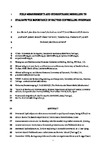Field measurements and hydrodynamic modelling to evaluate the importance of factors controlling overwash
| dc.contributor.author | Matias, A | |
| dc.contributor.author | Rita Carrasco, A | |
| dc.contributor.author | Loureiro, C | |
| dc.contributor.author | Masselink, Gerd | |
| dc.contributor.author | Andriolo, U | |
| dc.contributor.author | McCall, R | |
| dc.contributor.author | Ferreira, Ó | |
| dc.contributor.author | Plomaritis, TA | |
| dc.contributor.author | Pacheco, A | |
| dc.contributor.author | Guerreiro, M | |
| dc.date.accessioned | 2019-10-23T14:13:52Z | |
| dc.date.available | 2019-10-23T14:13:52Z | |
| dc.date.issued | 2019-07-09 | |
| dc.identifier.issn | 0378-3839 | |
| dc.identifier.issn | 1872-7379 | |
| dc.identifier.other | 103523 | |
| dc.identifier.uri | http://hdl.handle.net/10026.1/15054 | |
| dc.description.abstract |
Overwash hydrodynamic datasets are mixed in quality and scope, being difficult to obtain due to fieldwork experimental limitations. Nevertheless, these measurements are crucial to develop reliable models to predict overwash. Aiming to overcome such limitations, this work presents accurate fieldwork data on overwash hydrodynamics, further exploring it to model overwash on a low-lying barrier island. Fieldwork was undertaken on Barreta Island (Portugal) in December 2013, during neap tides and under energetic conditions, with significant wave height reaching 2.6 m. During approximately 4 h, more than 120 shallow overwash events were measured with a video-camera, a pressure transducer and a current-meter. This high-frequency fieldwork dataset includes runup, overwash number, depth and velocity. Fieldwork data along with information from literature were used to implement XBeach model in non-hydrostatic mode (wave-resolving). The baseline model was tested for six verification cases; and the model was able to predict overwash in five. Based in performance metrics and the verification cases, it was considered that the Barreta baseline overwash model is a reliable tool for the prediction of overwash hydrodynamics. The baseline model was then forced to simulate overwash under different hydrodynamic conditions (waves and lagoon water level) and morpho-sedimentary settings (nearshore topography and beach grain-size), within the characteristic range of values for the study area. According to the results, the order of importance of factors controlling overwash predictability in the study area are: 1st) wave height (more than wave period) can promote overwash 3–4 times more intense than the one recorded during fieldwork; 2nd) nearshore bathymetry, particularly shallow submerged bars, can promote an average decrease of about 30% in overwash; 3rd) grain-size, finer sediment produced an 11% increase in overwash due to reduced infiltration; and 4th) lagoon water level, only negligible differences were evidenced by changes in the lagoon level. This implies that for model predictions to be reliable, accurate wave forecasts are necessary and topo-bathymetric configuration needs to be monitored frequently. | |
| dc.format.extent | 103523-103523 | |
| dc.language | en | |
| dc.language.iso | en | |
| dc.publisher | Elsevier | |
| dc.subject | Storm impacts | |
| dc.subject | Hydrodynamics | |
| dc.subject | XBeach | |
| dc.subject | Runup | |
| dc.subject | Nearshore topography | |
| dc.subject | Video data | |
| dc.title | Field measurements and hydrodynamic modelling to evaluate the importance of factors controlling overwash | |
| dc.type | journal-article | |
| dc.type | Journal Article | |
| plymouth.author-url | https://www.webofscience.com/api/gateway?GWVersion=2&SrcApp=PARTNER_APP&SrcAuth=LinksAMR&KeyUT=WOS:000487172700019&DestLinkType=FullRecord&DestApp=ALL_WOS&UsrCustomerID=11bb513d99f797142bcfeffcc58ea008 | |
| plymouth.volume | 152 | |
| plymouth.publication-status | Published | |
| plymouth.journal | Coastal Engineering | |
| dc.identifier.doi | 10.1016/j.coastaleng.2019.103523 | |
| plymouth.organisational-group | /Plymouth | |
| plymouth.organisational-group | /Plymouth/Faculty of Science and Engineering | |
| plymouth.organisational-group | /Plymouth/Faculty of Science and Engineering/School of Biological and Marine Sciences | |
| plymouth.organisational-group | /Plymouth/REF 2021 Researchers by UoA | |
| plymouth.organisational-group | /Plymouth/REF 2021 Researchers by UoA/UoA07 Earth Systems and Environmental Sciences | |
| plymouth.organisational-group | /Plymouth/Research Groups | |
| plymouth.organisational-group | /Plymouth/Research Groups/Marine Institute | |
| plymouth.organisational-group | /Plymouth/Users by role | |
| plymouth.organisational-group | /Plymouth/Users by role/Academics | |
| plymouth.organisational-group | /Plymouth/Users by role/Researchers in ResearchFish submission | |
| dcterms.dateAccepted | 2019-07-07 | |
| dc.rights.embargodate | 2019-12-18 | |
| dc.identifier.eissn | 1872-7379 | |
| dc.rights.embargoperiod | Not known | |
| rioxxterms.versionofrecord | 10.1016/j.coastaleng.2019.103523 | |
| rioxxterms.licenseref.uri | http://www.rioxx.net/licenses/all-rights-reserved | |
| rioxxterms.licenseref.startdate | 2019-07-09 | |
| rioxxterms.type | Journal Article/Review |


